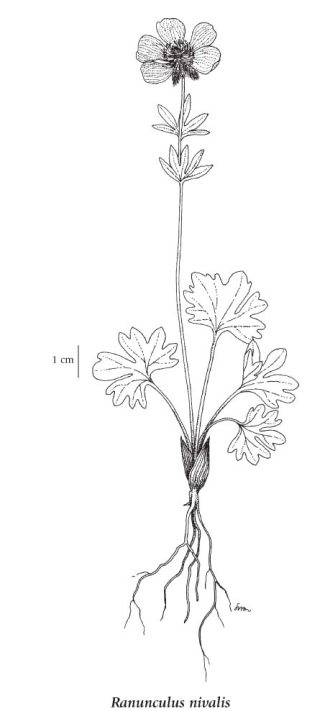Ranunculus nivalis L.
snow buttercup
Ranunculaceae (Buttercup family)
Introduction to Vascular Plants
snow buttercup
Ranunculaceae (Buttercup family)
Introduction to Vascular Plants
Species Information
General:
Perennial herb from short rhizomes with clusters of fibrous roots, with a stem base wrapped in brown, old leaf sheaths; stems stout, soft and fleshy, erect, 10-25 cm tall, smooth or sparsely-hairy.
Leaves:
Basal leaves persistent or deciduous, kidney-shaped, 3-parted, 0.6-2 cm long, 1.3-3 cm wide, the lateral segments and sometimes also the terminal segment again lobed or toothed, margins fringed, otherwise generally smooth, tips round-pointed, bases heart-shaped to squared-off, the stalks 1-5 cm long; stem leaves 1 to 3, alternate, short-stalked to unstalked, transitional to the unstalked, deeply 3- to 5-lobed bracts.
Flowers:
Inflorescence a 1- to 3-flowered terminal cyme; flower stalks brown-hairy or rarely smooth; receptacle smooth; petals 5 (6), distinct, yellow, 8-11 mm long, 7-12 mm wide, nectary on upper surface, small, the scale smooth; sepals 5, early deciduous or persistent, 6-8 mm long, 3-5 mm wide, densely brown stiff-hairy; stamens 70 or more; pistils 40-50.
Fruits:
Achenes, numerous (40 to 50) in a cylindric to egg-shaped head 7-14 mm long, 5-6 mm wide, the achenes egg-shaped, 1.5-2.2 mm long, 1.2-1.6 mm wide, smooth, obscurely keeled; beaks persistent, slender, 1-2 mm long, straight.
Illustration

If more than one illustration is available for a species (e.g., separate illustrations were provided for two subspecies) then links to the separate images will be provided below. Note that individual subspecies or varietal illustrations are not always available.
Illustration Source: The Illustrated Flora of British Columbia
Ecology
Ecological Framework for Ranunculus nivalis
The table below shows the species-specific information calculated from
original data (BEC database) provided by the BC Ministry of Forests and Range.
(Updated August, 2013)
The table below shows the species-specific information calculated from
original data (BEC database) provided by the BC Ministry of Forests and Range.
(Updated August, 2013)
| Site Information |
Value / Class |
||
|
Avg |
Min |
Max |
|
| Elevation
(metres) |
1683 | 1520 | 2240 |
| Slope
Gradient (%) |
16 | 0 | 70 |
|
Aspect (degrees) |
59 | 20 | 350 |
| Soil
Moisture Regime (SMR) [0 - very xeric; 4 - mesic; 8 - hydric] |
5 | 3 | 8 |
| Modal
Nutrient Regime
Class |
D | ||
| #
of field plots species was recorded in: |
19 | ||
| Modal
BEC Zone Class |
BAFA | ||
|
All BEC Zones (# of stations/zone) species was recorded in |
BAFA(15), cma(1), ESSF(1), SWB(2) | ||
|
Source:
Klinkenberg 2013
|
|||
Habitat and Range
Moist to wet streambanks, seepage sites, meadows, snowbeds and scree slopes in the subalpine and alpine zones; frequent in BC N of 55degreeN and E of the Coast Mountains; circumboreal, N to AK, YT and NT and E to Labr. and Greenland; Eurasia.Status Information
Synonyms
Synonyms and Alternate Names:
Ranunculus nivalis var. sulphureus (Sol. ex C.J. Phipps) Wahlenb.
Ranunculus sulphureus var. intercedens Hultén